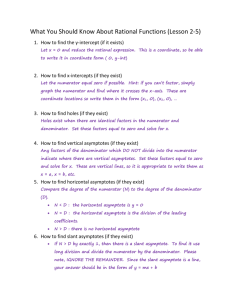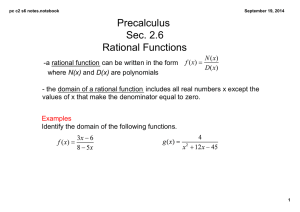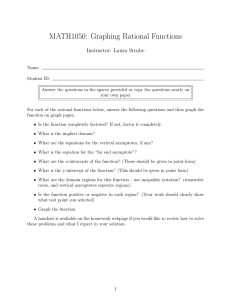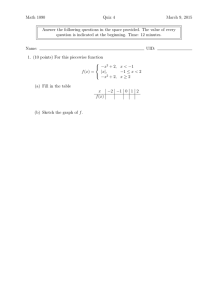Document 14230801
advertisement
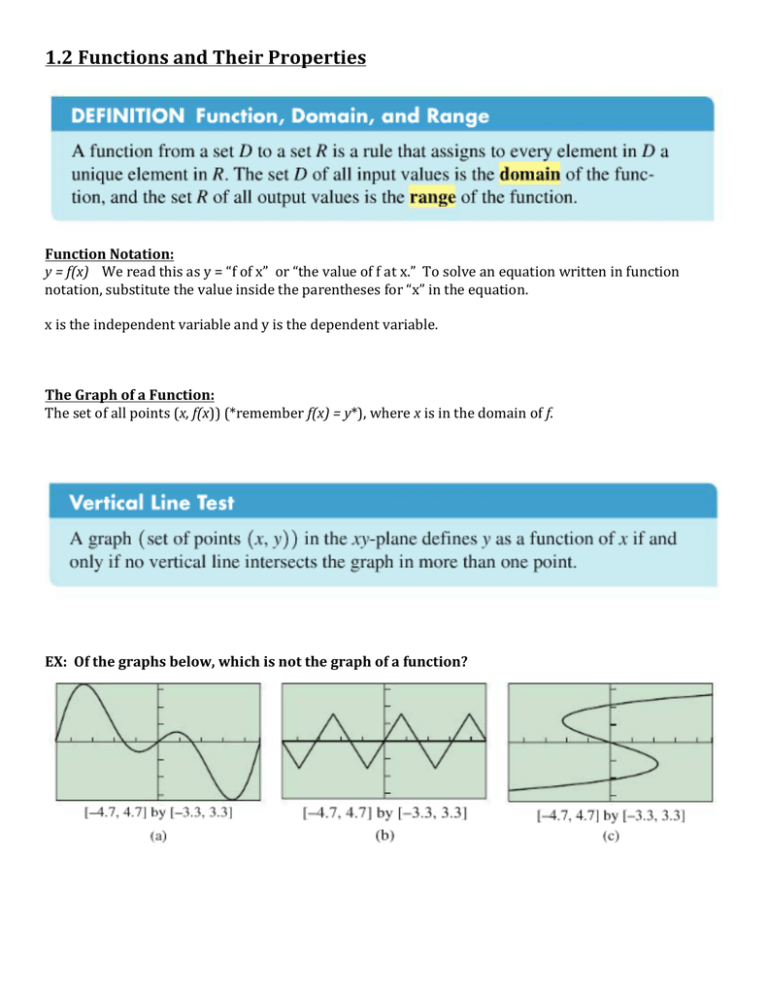
1.2 Functions and Their Properties Function Notation: y = f(x) We read this as y = “f of x” or “the value of f at x.” To solve an equation written in function notation, substitute the value inside the parentheses for “x” in the equation. x is the independent variable and y is the dependent variable. The Graph of a Function: The set of all points (x, f(x)) (*remember f(x) = y*), where x is in the domain of f. EX: Of the graphs below, which is not the graph of a function? DOMAIN AND RANGE: Domain: The set of all input (x) values for which the function is defined. Some equations may require restrictions on the domain. For example the area of a circle, A = π r 2 requires a restricted domain since we cannot have a radius that is negative. Functions that contain variables in the radical or in the denominator of a fraction would also require restricted domains. Why? Range: The set of all outputs. Finding the range is harder than finding the domain. One way to find the range is to look at the y-­‐ coordinates that correspond to points on the graph. Using a graphical and algebraic approach together is usually the best way to determine the domain. Continuity: Determining the domain and range of a function leads into another element of a function’s behavior called continuity. Functions can be continuous for all values of x or contain a discontinuity. The different types of continuity are shown below. *Basically a function is continuous if you can trace the entire graph without having to lift your pencil* *Continuity can also be described in terms of limits. A function is continuous if lim f (x) = f (a) . This x→a equation is read “the limit as x approaches a of f(x) equals f(a)”. Asymptotes: Asymptotes are boundary lines that the graph of a function gets closer and closer to, but will never cross. Vertical Asymptotes: The line x = a is a vertical asymptote of the graph y = f(x) if f(x) approaches ±∞ as x approaches a from either direction. They occur at x-­‐values for which the function is undefined. EX: A) Based on the graph below, name the vertical asymptotes. x B) The graph above is of the function y = 2 . Verify your answer from part A x −x−2 algebraically. ***If a factor in the denominator cancels out with a factor in the numerator the result is a hole (removable discontinuity), not an asymptote (non-­‐removable, infinite discontinuity)*** Horizontal Asymptotes The line y = b is a horizontal asymptote of the graph of the function y = f(x) if f(x) approaches b as x approaches ±∞ . EX: Find the horizontal asymptote in the graph below. To find horizontal asymptotes without graphing we compare the degree of the numerator and denominator. If the degree of the numerator is… a) less than the degree of the denominator, the horizontal asymptote is y = 0 (x-­‐axis) b) equal to the degree of the denominator, the horizontal asymptote is the ratio of the lead coefficients. c) greater than the degree of the denominator, there is no horizontal asymptote. x EX: Verify your answer above using the equation y = 2 . x −x−2 EX: Find all horizontal and vertical asymptotes for the functions below. Confirm your answer using your graphing calculator. x +1 2x + 5 x2 a) f (x) = 2 b) f (x) = c) f (x) = x −1 4x − 6 x +1 Increasing and Decreasing Functions: EX: Determine the interval for which the graphs are increasing, decreasing, or constant. Boundedness: A function f is bounded below if there is some number b that is less than or equal to every number in the range of f. Any such number is called the lower bound. A function f is bounded above if there is some number B that is greater than or equal to every number in the range of f. Any such number is called the upper bound. A function f is bounded if it is bounded both above and below. EX: Based on the graphs, are the following functions bounded below, bounded above, or bounded? Find the lower bound, upper bound, or both. a) b) *** How would determining intervals of increasing and decreasing and boundedness help us in finding MAX and MIN points? EVEN AND ODD FUNCTIONS: A function is even if for all x in the domain of f, f(-­‐x) = f(x). In a graphical sense, this means that the function is symmetric with the y-­‐axis. A function is odd if for all x in the domain of f, f(-­‐x) = -­‐f(x). An odd function is symmetric with respects to the origin. This means two things: 1) The of an odd function must pass through the origin 2) The graph will look the same upside-­‐down as it does rightside-­‐up.


